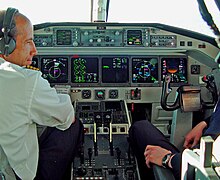Saab 2000: Difference between revisions
Jan Eduard (talk | contribs) →Operators: correct link added |
|||
| Line 190: | Line 190: | ||
==External links== |
==External links== |
||
{{commons|Saab 2000}} |
{{commons|Saab 2000}} |
||
* [http://paffalcons.com/gallery/saab2000/index.php Picture Gallery - Saab 2000 Erieye AEW&C] |
|||
* [http://www.saabaircraftleasing.com/prod/pictures.asp?Mod=2000&Menu=33 SAAB Aircraft Leasing] |
* [http://www.saabaircraftleasing.com/prod/pictures.asp?Mod=2000&Menu=33 SAAB Aircraft Leasing] |
||
* [http://www.aerospace-technology.com/projects/saab_2000/ Aerospace Technology] |
* [http://www.aerospace-technology.com/projects/saab_2000/ Aerospace Technology] |
||
Revision as of 10:23, 25 November 2010
| Saab 2000 | |
|---|---|

| |
| Darwin Airline Saab 2000 | |
| Role | Passenger aircraft |
| Manufacturer | Saab |
| First flight | 26 March 1992 |
| Introduction | 1994 |
| Status | Out of production |
| Primary users | Carpatair Eastern Airways FlyLal Golden Air Polet Airlines |
| Produced | 1994-1999 |
| Number built | 64 (54 still in service) |
The Saab 2000 is a turboprop airplane able to cruise at a speed of over 665 km/h (360 kt).
Development and Design
Saab decided to build the 2000 in December 1988 due to perceived demand for a high speed turboprop which could approach the speeds of jet aircraft while retaining the efficiency provided by turboprop engines. The Saab 2000 first flew on 26 March 1992 and entered into scheduled airline service in 1994, a few months after its certification by the Joint Aviation Authorities in March and the Federal Aviation Administration in April.
The Saab 2000 had a 15% greater wingspan than the Saab 340, and being over 24 ft. 9 in. (7.55m) longer could fit up to 50 passengers. The 2000 was the first commercial aircraft to use the 4,591shp Rolls-Royce AE 2100 turboprop engines (then built by Allison), driving slow turning six-bladed Dowty Rotol propellers. One engine was mounted on each wing, as in the 340, with the engines placed farther from the fuselage than those of the 340.
Production and operational service

Sales of the Saab 2000 were fairly limited. The major initial customer was Crossair, a regional airline which had Swissair as a 56% shareholder. Crossair took delivery of 34 aircraft and was still operating the type in 2005. Due to limited demand, Saab ceased production of the Saab 2000 in 1999.

By the year 2000, 54 Saab 2000 aircraft remained in service. The primary reason for the low sales was the success of the newly introduced low-cost regional jets such as the Bombardier CRJ and Embraer ERJ 145 family which provided better performance and passenger comfort for the same initial price. Some smaller airlines, including Eastern Airways in the UK, have subsequently acquired 2000s at low cost and operated them on regional routes which experience lower passenger numbers.
In June 2006, Pakistan finalized the purchase of six Saab 2000 turboprop aircraft to be equipped with the Saab-Ericsson ERIEYE Airborne Early Warning system. Revised in May 2007 due to renegotiation with the Government of Pakistan, only five aircraft will be delivered, four of which will be equipped with the Erieye system. On April 3, 2008, the first Saab 2000 Erieye AEW&C was rolled out and presented to Pakistan Air Force officials during a ceremony in Sweden.[1]
Variants
- Saab 2000: 50-seat regional airliner.
- Saab 2000FI: Flight inspection aircraft for the Japan Civil Aviation Bureau, two produced.
- Saab 2000 Erieye AEW&C: Airborne Early Warning & Control variant fitted with Erieye radar and associated mission systems.
Operators
Civilian operators


Saab 2000 fleet list as of September 2010, from Saab Aircraft Leasing:
- Carpatair (12) - biggest Saab operator worldwide
- Darwin Airline (6)
- Eastern Airways (8)
- Ginn Racing (2)
- Golden Air of Sweden (8)
- Egyptian Government (2)
- Hendrick Motor Sports (3)
- Joe Gibbs Racing (2)
- Moldavian Airlines (2)
- Ostfriesische Lufttransport (3)
- Polet Airlines (5)
- Pakistan Government (3)
- Japan Civil Aviation Bureau (2)
- Lithuanian Airlines (1 stored)
Two aircraft have been dismantled (#001 #003). #002 (non airworthy) is used for engineering training at Flygteknik Technical Training in Nykoping, Sweden. Two have been written off (#047, #053).
Former civilian operators
Crossair AG
Military operators

 Egypt 3 saab 2000
Egypt 3 saab 2000
- Pakistan Air Force (PAF) - 5 Saab 2000, including 4 AEW&C variants fitted with Erieye radar and associated systems.[2][3]
Specifications
General characteristics
- Crew: Flight deck crew of two, Cabin crew one or two.
- Capacity: *Normal passenger accommodation for 50 at three abreast and 81 cm (32 in) pitch.
- Max seating for 58 at three abreast and 76 cm (30 in) pitch, with repositioned galley and wardrobe
Performance
Avionics
- Rockwell Collins Pro Line 4 avionics suite with integrated avionics processor (IAP)
See also
Related development
Aircraft of comparable role, configuration, and era
- Antonov An-24/Xian Y-7/Xian MA60
- Antonov An-140
- ATR 72
- BAe ATP
- Bombardier Dash 8
- CASA CN-235/EADS CASA C-295
- Fokker 50
- Ilyushin Il-114
Related lists
